[box]Since I wrote this, I have discovered the culprit is cabbage maggots, which you can read about in Ants, Cabbage Maggots, and Broccoli. I may still experiment with vaseline to smoother eggs or deter egg laying, but the ants were actually the good guys here. If you are looking ways to deter ants in the house or in inconvenient places in the garden, Tips Bulletin has a thorough article called 8 Natural Ant Remedies.[/box]
Every spring, when my broccoli and cabbage get a couple inches high, the ants come. At first, I thought they were just climbing around looking for aphids or something. (This is what I wrote 3 years ago) But after some closer observation, I am suspicious they are chewing away the bases of the stalks of the plants just at soil level. They don’t just chop it down and drag the plant away. I think they might be exposing the stem enough to suck the juices from the plant, because the plants die a long, slow death, turning shades of purple and grey before completely withering away. I have tried many things to deter the ants. I have used diatomaceous earth faithfully. I have put cardboard rings (made from toilet paper rolls) around the plants when they first sprout, then let them grow up through that. These two methods had no observable impact on the ants. I have gone out every couple of days and sprayed the ants with Bonide brand Eight™ insect control. This killed the ants that day, but they were always back in force soon. I have rotated my crops, but the ants always seem to know where to look. I have tried to over-plant, so that I can just sacrifice a few plants. I would still end up losing a lot of my broccoli and cabbage seedlings. Not only that, but the ants would hang around and keep it up until the heat of summer made them seek more time underground. Then, this winter, I had trouble with fungus gnats in my greenhouse and was introduced to sticky tape in a whole knew way. All of a sudden, I knew I needed to try putting sticky tape on sections of PVC pipe to create mini shelters for my seedlings. I wondered if this just might work as a natural, non-toxic ant control barrier.
The first thing was to find some double sided sticky insect tape. It apparently only comes in really big rolls (530 feet). I now have enough to make enough mini plant shelters for the rest of my life, so I really hope this turns out to be a good long term solution. On the bright side, the roll was only about $45 by the time shipping was included. The best deal for yellow sticky tape I could find was on amazon.com. And there are many other potential ways to use it, like wrapping it around plastic cups to keep near the top of mature cole crops to trap the aphids.
Next, I talked to my husband about his stock pile of PVC pipe, which he willingly shared. He even said we should also try some of his ABS piping, which is black. The most common PVC is white. This would enable me to compare any differences in heat retention due to pipe color, as the inside of the pipe would not (as of this first experiment) have sticky tape on it. He has previously taught me to saw through PVC pipe with a hand held blade, but this time he offered to cut the multiple pieces with his table saw. I decided that 2 inch pieces of pipe would be tall enough. Any taller and the little newly sprouted plants wouldn’t be able to get any sunlight! He quickly cut off about 15 sections of pipe for me. (click on any photo to enlarge)
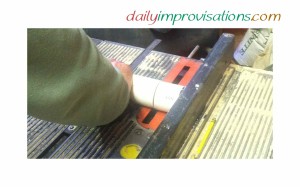
The roll of sticky tape has one layer of non-double sided tape around the outside, presumably to keep it from sticking to everything in storage and transit. I hung that section up in my greenhouse to catch the last of the gnats flying around, but in retrospect, I should have saved it for future storage of the rest of the roll. I wish I could say I had remembered the width of the sticky tape, but I didn’t and cannot take any credit for the fact that its 2 inch width was a perfect fit for my mini pipe shelters. It was not hard to wrap around the pipe and cut the tape where I wanted, but I wasn’t going for perfection either, so there were some bumps and uneven places. The tape was not so sticky that it clung to my hands while working with it, but it did take several washings with soap before my fingers were free of the residue. Still, the whole outer circumference of each pipe section was covered in a matter of a couple of minutes. Soon I had several sticky mini shelters for my broccoli that had just shown its first leaves above ground.
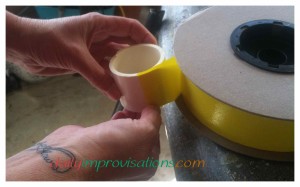
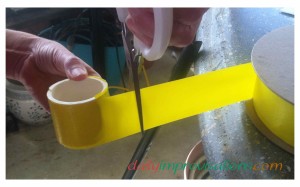
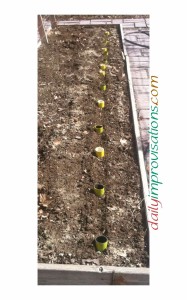
Enough of the seeds had sprouted that I was able to choose nicely spaced plants to put the guards around. I pushed the bottom edge of the pipe circle into the soil a fraction of an inch, mostly to make sure there were not places the ants could easily crawl under. I know that sometimes they seem to come up right at the base of the stalk, but then they always have a trail going somewhere. I figure if they can’t make a trail because they are getting stuck to the yellow sticky tape, then I have cut off some important feature of their strategy!
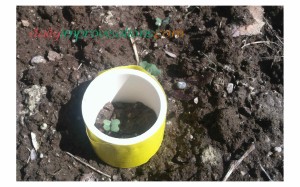
I wasn’t concerned about the wind and rain. I had seen how the sticky tape in the greenhouse had stayed nice and sticky through all waterings. I had not kept it dry at all and I touched it once in a while to see if it was still working. The height of the pipe was not enough to catch much wind and it was a heavy enough to stay put. A couple days of vigorous rain right after I put them around the seedlings allowed me to validate that this was correct. In spite of quite a bit of wind, there were only scattered tiny specks of dirt on them, they were solidly in place, and they still felt sticky.
Report: April 27th was the first day I found ants on my broccoli. Boo. It had been raining off and on for several days, so I hadn’t been out in the garden much. The ants had been active enough though, which surprised me with all the rain. They were coming up right at the base of the stalk, not just walking around on the ground surface like I had thought when I saw them before. I know they live underground! I just hadn’t seen that they were burrowing right there.!
They had destroyed 3 broccoli seedlings in one raised bed. They haven’t found their way to the larger row of broccoli, in a raised bed farther away from the dry, road-mix work area where there is evidence of many ant hives. So, maybe that is a clue. But maybe they will get over there sooner or later? I have filled in the ant holes around the base of the still surviving, but seriously compromised, broccoli plants, and pushed the PVC pipe about about an inch into the ground.
Now, I have decided to smear vaseline around the base of the broccoli that is being attacked or is in the attack zone. I put a large glob on flat stick to carry it out to the garden. I used my finger to spread it on and around the base of the broccoli. This was not easy. The best way was to just lay down sections of mini-slabs of it, trying to begin at the stem. The ant activity was immediately limited. Some ants did get stuck in it and died. I’m okay with that. I put the vaseline around both plants that were already severely compromised and those that were untouched. I know from experience that once ants have started in area, all the plants are at high risk. This article is a pretty even handed review of petroleum jelly, if you are interested.

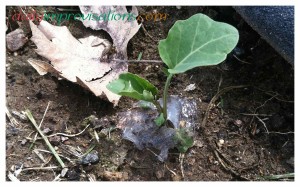
If this does not work well for long term, maybe I will try a mix of soap and garlic. Maybe I will resort to Bonide again. Maybe I will continue to try to spread diatomaceous earth in hopes of at least slowing them down. Reminds me of a book on gardening by a man who had had certain ideals (when he lived in an apartment in the city) before he actually had to deal with pests and other elements of destruction. It is easy to be “at one with nature” until it is eating all your hard work as fast as you can plant it!
The sticky traps are still a little sticky, and even have a few other bugs on them. Compared to previous years, it seems I have fewer losses due to pill bugs munching on the new leaves of the little seedlings, so that is at least good news. But I don’t think I can give the sticky traps credit for that in the one row, because many of the unprotected seedlings are fine, too. The broccoli is not at risk from pill bugs after a certain size.
If I want this sticky trap system to work much longer on any bugs, I’ll have to change out the sticky tape. This would have to be done soon, because soon the plants will be too large to slip the pipe over. I might just wait and see how the sticky tape works to trap aphids if hung up near the top of the broccoli plants. Meanwhile, I will be keeping an eye on ant activity, and possibly looking for ways to devastate hives in the work yard.
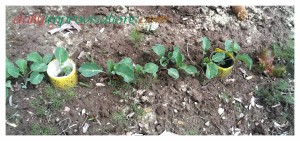
Another Report: May 2 – The vaseline has continued to deter the ants. The broccoli seedlings that had been healthy are still going strong. The ones that had been surrounded previously by the ants ended up dying.
I had decided to implement to a two front war strategty. Not only did I need to protect the seedlings, I needed to try to destroy any ant hives I could find near there. Research reveals a number of poisonous bait options, but I am very concerned about young grandchildren and pets getting into it. This dad went into nighttime stealth mode and won at least one ant battle, while keeping his son safe. If you dont know where the ants are coming from, his method could help.
This list of many ant interventions was interesting, but so many of the ideas were still poisonous or might render my soil lifeless. So I went back to considering diatomaceous earth, but on a new level. This time, I sprinkled it heavily where I saw them swarming about 5 feet away from my broccoli row. The affects were much more dramatic than spreading it around the broccoli, where there was activity, but not by nearly this many ants. This time there was mass confusion. I could see some of the ants keel over right away. Some of them dropped off of the edge of the pavers like soldiers shot off of castle walls.
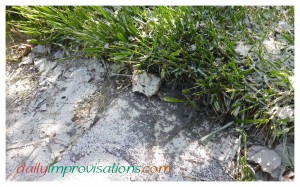
When I went back to check the next day, there were no ants to be seen there, but activity had picked up a few feet away. I attacked the workers with diatomaceous earth again. It seems that no matter what method I try, when those seedlings are succulent, I need to be ready to do ant warfare every day.
